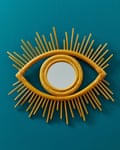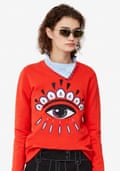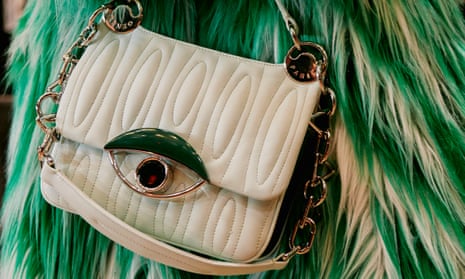Once you start noticing the evil eye, you can’t stop seeing it. Or rather, it can’t stop seeing you. The eye, whose “pupil” often comes in cobalt blue and is occasionally adorned with eyelashes, has been a recurring motif in fashion over the years, from the necklace worn by Willow Smith for Chanel’s AW16 eyewear campaign, to Elie Saab’s eye-embellished dresses from the spring 2017 couture collection, to Gigi Hadid’s Eyelove and Eyelovemore shoe designs with Stuart Weitzman the same year. But, more recently, the trend has intensified.
The Guardian’s product and service reviews are independent and are in no way influenced by any advertiser or commercial initiative. We will earn a commission from the retailer if you buy something through an affiliate link. Learn more.
Coach 1941’s 2019 Cruise collection put an evil eye on sweaters, while Nicole Miller’s most recent show included a scattering of eyes across jackets, dresses and skirts. When Asos launched its homeware collection, Supply, at the beginning of the month it contained an “eye see you” cushion cover, bedspread and bath mat, as well as an eye-shaped mirror. Topshop is selling evil eye ankle socks and the symbol can be seen on sold out T-shirts from Urban Outfitters and on sweatshirts, bags and shoes at Kenzo.

The origins of the evil eye lie are talismanic, rooted in the belief that a malicious look or stare, often prompted by envy, can bring misfortune to those receiving it. However, wearing or displaying one of these in amulet form – confusingly also referred to as the evil eye – can help ward off said curse. Others believe that receiving undeserved levels of praise or attention can also lead to evil eye-based misfortune. Either way, the concept is one which transcends religions, generations and cultures, with early versions thought to date back to 3,300 BC, although the symbol has remained particularly prevalent in Mediterranean countries.
These symbols can often be found in homes, painted on walls, doors and furniture. Historically though, it has been jewellery where the evil eye is most ubiquitous. In Turkey, handmade glass bead versions of the eye, known as nazars, are still worn as talismans.

“The trend reminds me of the opulent Egyptian-inspired fashions of the 1920s, when the evil eye was sometimes referenced in designs for jewellery, headdresses and beading and embroidery,” says Susanna Cordner, a senior research fellow at the London College of Fashion. “Conversely, in the 30s, Elsa Schiaparelli frequently included padlocks in her designs as a supposed means of warding off the evil eye.”
Fashion has long been drawn to talismanic designs, from pendants bearing the image of saints to the hamsa (a palm-shaped amulet). According to the fashion search site Lyst, necklaces and rings are the most searched categories when it comes to evil eye-inspired designs, with Missoma, Sydney Evan and Tory Burch the most viewed labels.
Cordner also raises question of whether the eye’s popularity is a reflection of “contemporary anxieties … drawing us back to talismans we found comfort in in the past”. In terms of their fashionability, the evil eye has followed a similar trajectory to crystals and certain aspects of the occult, coming to exist in spaces that explore everything from mysticism to wellness. On Instagram, a search for “evil eye tattoos” prompts 6,926 results – almost twice as many as “astrology tattoos” at 3,919. Doubtless they are aesthetically pleasing, a symbol that embraces symmetry and leaves room or originality – but is there more to it? In uncertain times, it makes sense that we would turn to emblems that offer some comfort – and perhaps a horseshoe and rabbit’s foot no longer cut it.
“Coincidentally – or not, depending on your own belief system – the founders of several of the most significant fashion houses today – Coco Chanel, Christian Dior, Yves Saint Laurent, for example – were extremely superstitious, with particular interests in tarot and astrology,” says Cordner. “In contrast, their successors have gone on to translate – or arguably appropriate – that private belief into a public muse.”
Given that Pope Francis last year voiced his disapproval regarding the wearing of crucifixes as fashion items – rather than because of their religious significance – could trend-based appropriation of the evil eye prompt similar condemnation? Certainly there’s an argument that it should, yet the fact that the evil eye spans cultures and belief systems may be why this symbol has escaped more damning accusations of cultural appropriation.

The French luxury fashion house Kenzo is one of the most prolific users of the eye motif, referring to it as “an emblem for the modern era of the house”. Yet, to Cordner, it less resembles the evil eye and more the “lover’s eye” jewellery designs of the 18th and 19th centuries.
“Wearing a tiny portrait of your lover’s eye as a piece of jewellery was an illicit and intimate way of showing your love,” she says. “This would completely change the tone of the design. It becomes an act of affection rather than of superstition.”
For Kenzo, the latest eye-inspired addition to its accessories line is an eye-bearing bag. “We called it the ‘Tali’ bag, as it felt appropriate to carry the eye as a talisman for good fortune and luck,” say the brand’s creative directors, Carol Lim and Humberto Leon. As they put it: “Who wouldn’t want to feel that type of karma every day of their lives?”
